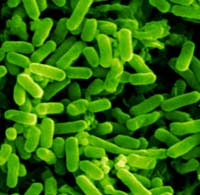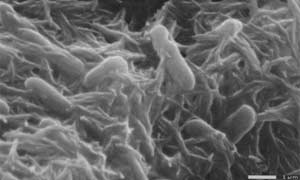Strange 'resistance' of earth bacteria

E-coli
The two most common bacteria - E-coli and Shewanella Oneidensis (SO) have surprised scientists, because they can survive under a test pressure greater than 17,000 times normal atmospheric pressure and in one Water environment is polluted by formate (formic acid).
US scientists from Carnegie University have taken millions of E-coli bacteria from human colonies and such a number of SO bacteria from manure into water with formic acid added. The whole sample is then placed in a high-pressure device used to make artificial diamonds. Under a pressure of 249,000 pounds per square inch (249,000 x 45.4kg / 25.4mm2) the water mass turns into a crystal that is much higher in density than normal ice and is called Ice-6. After a few hours under this pressure, the Ice-6 crystalline mass was analyzed and it was amazing to see that more than 1% of a million bacteria still existed normally. More specifically, the number of bacteria surviving above has used formate as a nutrient by special metabolism to turn formic acid into carbon dioxide and hydrogen.

Bacteria Etremophiles
From this experiment, it is still possible to exist from simple to complex depths within a few tens of kilometers underground. Earlier, the scientists discovered a bacterium with the name extremophiles that exists and grows in a high temperature environment that is heavily contaminated with radiation and acid. These proofs show that limiting the search for life on outer planets with similar conditions in the world is not satisfactory.
So far, NASA satellites that only probe the surface of a strange planet and hastily conclude there is no life there is a mistake. Life can lurk under their surface and so the area of life that scientists have limited in the previous universe may have to expand many times.
The condition of the test just now compared to the moon, Mars and Jupiter is extremely harsh and unimaginable. So the life of low-level animals in the ice block on the planets is visible. As for other planets, after this experiment, no one can claim that it is a "dead land".
Nguyen Thanh Binh
- How did bacteria learn to fight antibiotics?
- Drug resistance of the virus
- Solving the phenomenon of drug resistance by giving bacteria 'fighting' together
- International space station infected with strange bacteria
- Antibiotic resistance can be passed from mother to child
- Bio-nano robot will help end the antibiotic resistance crisis
- WHO put recommendations on what to do to prevent the spread of resistant bacteria
- The principle you must remember in an age of nightmares 'antibiotic resistance'
- Resistant bacteria can spread through the air, and this is not good news
- 10 reasons why antibiotic resistance is scary right now
- Three types of antibiotics defeat the most dangerous drug resistance gene of the virus
- Learn about the phenomenon of antibiotic resistance
 Why do potatoes have eyes?
Why do potatoes have eyes? 'Tragedy' the world's largest carnivorous life: Death becomes ... public toilet
'Tragedy' the world's largest carnivorous life: Death becomes ... public toilet Tomatoes were once considered 'poisonous' for 200 years
Tomatoes were once considered 'poisonous' for 200 years Detecting microscopic parasites on human face
Detecting microscopic parasites on human face